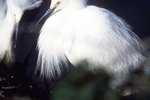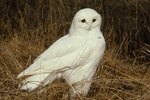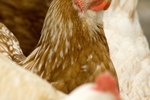While many birds require DNA testing to definitively distinguish males from females, the ostrich is one bird whose sex is easily determined visually. Their coloring is the first indication, confirmed by different behavior between males and females.
Adults Brown or Black
Mature male ostriches – called roosters – have distinct black feathers covering their backs and around their sides, with white underside and tip of the tail. Females – called hens – by contrast, are light brown. When they are ready to mate, the male’s beak and shins turn red, and the female’s feathers turn silver.
Babies Harder to Tell
Ostrich hatchlings are greyish brown, whether they are male or female. At about four months old, regardless of their sex, their plumage turns brown. Eventually, when they reach sexual maturity, they will acquire the coloring that identifies their sex. This occurs around the age of three or four years.
Tips
Male ostriches tend to be significantly larger and heavier than females. Males grow to be between 6.9 and 9 feet tall and weigh up to 279 pounds. Females range from 5.7 to 6.2 feet tall and weigh as much as 242 pounds.
Mating Behavior
Ostriches travel in herds ranging from groups of five to 100, though most have around 10 birds. The herd has both a dominant male and a dominant female. Other, more passive females are part of the herd, while other males may come and go. When he wishes to mate, the dominant male performs an elaborate mating dance to impress the dominant female. He bows or crouches down, stretches his wings and displays his plumage, shaking both his wings and tail, then alternates putting each wing forward. If the female is interested, the two will mate. Then other females may mate with the dominant male or with other transient males.
Watching and Protecting
When the female is ready to lay eggs, the male digs out a nest in the ground. The dominant female will lay between 7 and 10 eggs in the center of the nest. Other females will place their eggs around those of the dominant female. Both male and female ostrich take turns sitting on the eggs until they hatch, after about 35 to 45 days. If a predator -- such as a lion, cheetah, hyena or crocodile -- threatens the eggs, the male will chase and distract the intruder or attack it with a powerful, deadly kick while the female continues to sit on the eggs. Later, once the eggs hatch, both sexes care for the chicks. If threatened, though, the male will again hold off the predator while the female takes the chicks and hides.
Heard in the Herd
Both male and female ostriches regularly snort, whistle and snap their bills. But when scaring away a predator, especially at night, the male may make a loud noise somewhat like the roar of a lion to warn the herd that danger is lurking nearby.
References
Writer Bio
Barbara Bean-Mellinger is an award-winning writer in the Washington, DC area. She writes nationally for newspapers, magazines and websites on topics including careers, education, women, marketing, advertising and more. She holds a Bachelor of Science from the University of Pittsburgh.





